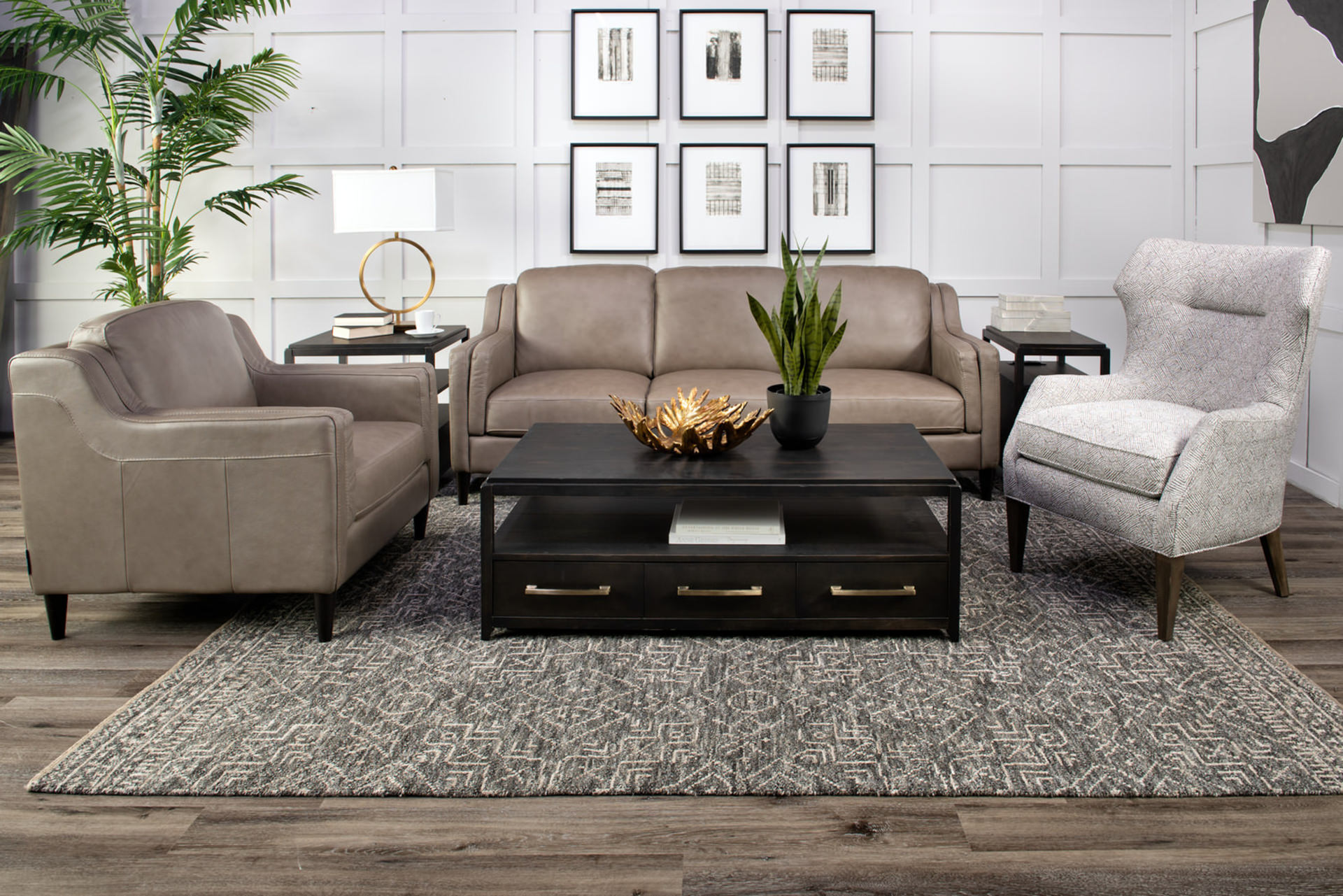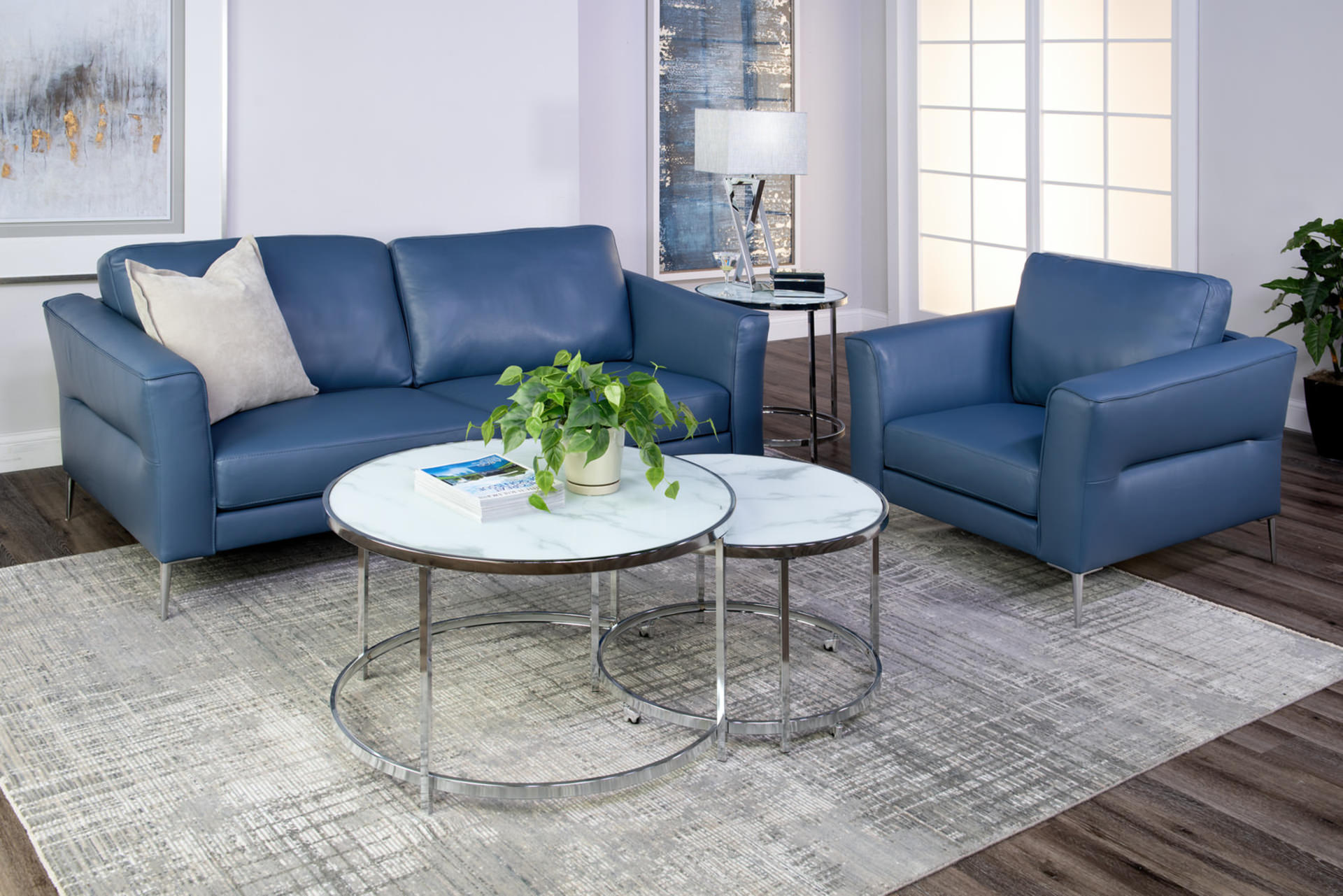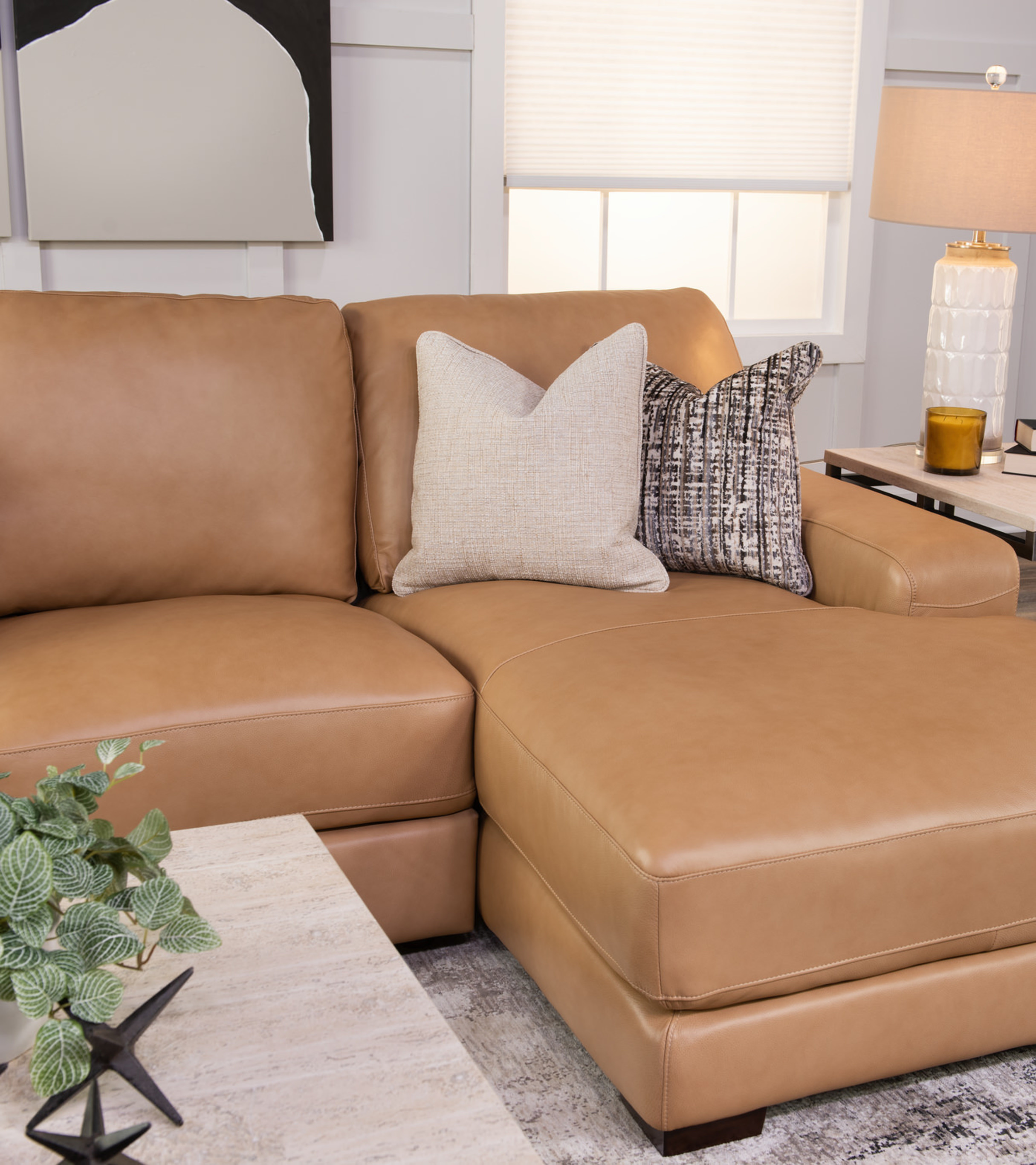Leather Furniture Buying Guide

When you think of leather furniture, there are plenty of positive attributes that come to mind. You may think of warmth, sophistication and high style. This natural upholstery material is a durable, flexible and stylish option that’s a top-notch pick for your well-appointed living space.
However, there are also some misconceptions about leather furniture that may have you thinking it’s not an ideal choice. Like every type of fabric, leather has some benefits and drawbacks. Weighing these factors will help you determine whether or not it’s the right pick for your specific environment and decorating style.
There are also many types of leather to choose from, which can greatly impact the look of your furniture and the longevity of the piece, as well as the price tag. Learn about the advantages and considerations of leather furniture, the different types of leather, as well as care and maintenance guidelines to determine if leather furniture is right for you and, if so, what is the best leather sectional, sofa, loveseat or chair for your home. Keep reading for more information on selecting what is sure to be your next favorite piece of furniture.
Advantages of Leather Furniture

There are a lot of reasons why people choose leather furniture. Some simply like the style and feel of real leather. There’s nothing quite like it. Here’s some other advantages that leather furniture can bring to the table, err, sofa.
- Longevity – It’s true that leather furniture typically costs more than other fabric pieces. However, there are good reasons for the price. Leather furniture can be a good investment, because leather is such a durable material. A quality leather sofa or other piece of leather furniture can easily last a lifetime with proper care and moderate use.
- Strength – As stated, leather is a durable fabric. While all furniture can be damaged from scratches and rough use, leather furniture can typically stand up against a lot of wear.
- Uniqueness – Leather furniture is going to get marks and scratches over time, especially from active families. One of the beauties of leather is that imperfections can enhance—not take away from—the appeal of the piece. These marks give leather character, making each couch, loveseat and chair one-of-a-kind pieces with their own stories to tell.
- Ease of cleaning – Leather naturally resists a lot of moisture and staining. Plus, there is a huge variety of leather furniture cleaners on the market that help you safely maintain and clean leather pieces. Just make sure to keep your favorite on hand. It’s important to act quickly to clean up stains and spills.
- Timeless style – Whether you opt for a traditional leather sofa or a sleek and slim modern chair, leather pieces are always in style.
Leather Considerations

While leather offers many advantages, luscious good looks included, it’s not for everyone. Here are a couple of considerations to think about when deciding on purchasing leather furniture for your home.
- Cost – Since it’s produced from real animal hides, leather furniture is generally going to come with a significantly higher price tag than similar furniture made from fabric options. When considering a leather furniture purchase, it’s important to weigh the cost investment vs. the style, longevity and other advantages.
- Limited Selection – You’ll find a range of neutral and solid color options, as well as different furniture styles in the leather section of your furniture showroom. Comparatively speaking, however, there are less leather options to choose from than upholstered fabrics, since there are less color options and no patterns.
Types of Leather Furniture
Leather is a natural, durable and flexible material created by tanning animal rawhides, the most common of which comes from cattle. The part of the hide used in manufacturing drastically affects the appearance, texture and durability. Here are the basic types of leather that are used for furniture, and how the type impacts the appearance and performance of the furnishings.
- The top cut (epidermis) layer, depending on how it is processed, can become full grain leather or corrected grain leather, which is commonly referred to as top grain.
- Full-grain leather furniture has the complete (full) grain of the hide intact and will show natural markings. The leather does not undergo any sanding, buffing or processes to remove the hide’s visual imperfections. This results in a naturally soft and supple leather feel. Full grain leather also offers performance benefits. It is the most durable and resistant to wear because the outer grain remains intact with all of its natural cross grain fiber strength. On the other end of the performance spectrum, it is the most susceptible to liquid penetrations due to the hide’s porous nature. Full grain leather is the most expensive form of leather even though it has been processed the least. It will develop a rich patina over time and will become more beautiful with age.
- Top grain leather is similar to full grain leather, but it is sanded, buffed and refinished to remove natural markings and give it a uniform, smooth and soft surface. Top grain leather is more commonly used than full grain leather in the furniture industry. This is due to some of the advantages it offers, including flexibility, durability and lower cost.
- The bottom cut (dermis) layer is what is left over after the top cut is removed. It is commonly referred to as split leather. Depending on the original hide’s thickness and how thick the top cut is, this layer can in some instances be split again.
- Split-grain leather does not have any of the hide’s original grain or the wear and tear strength of full grain and top grain leathers. The biggest advantage of split-grain leather furniture is the lower price point. Split leather that is used in sofas and other furniture can have an artificial top coat applied to seal the surface in order to give an appearance resembling that of top grain leather.
- Bonded leather is typically constructed of shredded leather that is bonded together. It is more economical, and a good option for those that love the look of leather but are priced out of the more expensive options.
- Aniline leather is another term to know when considering a premium leather furniture investment. Only the finest hides in the world fall into the category of pure aniline leather; while full aniline leather includes leather where a slight protective finish is applied in the tanning process to give it some extra serviceability.
- Aniline plus or semi-aniline leathers are processed more. Spray pigments of color are applied to the tops of the hides to even out the finish and camouflage naturally occurring imperfections. These leathers are fade resistant and scratch resistant and are easily cleaned.
Leather Care and Maintenance

It’s important to know what to expect when making a leather furniture purchase. Here are some expectations for leather furniture, as well as care and maintenance guidelines.
- All leather fades in direct sunlight and can fade in in-direct sunlight as well. Fading is a normal wear characteristic, not a defect.
- Periodic cushion rotation (when applicable) ensures even wear and compression of cushions. Please note: 15% to 20% loss of resiliency in foam cores is considered normal. Sitting in the same spot on a sofa will be noticeable unless cushions are rotated.
- Color variation is normal. Natural leather will also have color variations even in the same hide. Nubuck leather will all have color variation within, caused by the angle that light hits these fibers. These variations become part of the character and unique beauty of the piece.
- Hide marks on leather are normal. Scars, brands, stretch marks, barbed wire marks, etc. all fall under the category of hide marks and are noticeable on all genuine leather products and are not considered defects.
- Leather furniture will develop a patina and comfort lines. This happens where you regularly sit as a result of leather stretching to fit your body.
- HOM Guard Protection Program is available for all leather furniture. It warrants you against rips, tears, burns, cracking, peeling, ballpoint pen marks, and staining from anything people eat or drink, and any human or pet bodily fluids.
Leather Furniture FAQs
Still have questions about leather furniture? So do others! Here are some frequently asked questions, and answers to guide you in the leather furniture selection process.
1. Is leather cold and uncomfortable in cooler rooms?
It’s a common misnomer that leather furniture is cold and isn’t a good choice for cooler spots in your home, like basements. The truth is that leather warms to match your body temperature pretty quickly. Therefore, it can actually help keep you warm in the cold. Leather is also a good option for warm rooms, such as upstairs living spaces, as the fabric won’t get as hot to the touch as other materials.
2. Is leather furniture hard to care for and maintain?
Leather furniture does take some basic maintenance to stay in prime condition and offer the best longevity. It’s important that leather furniture is regularly wiped down with a dry cloth. All spills should be cleaned up immediately. Also, you should always use a leather cleaner as opposed to other generic household cleaners. With these basic care steps in mind, leather is an excellent choice for its robustness and long expected life.
3. Should leather furniture be avoided by families with young kids and pets?
No! In fact, leather’s durability and other strengths make it a good choice for active households. Inevitable scratches and wear will lead to slight “imperfections”, but these marks can actually add to the character and unique look of your leather furniture over time.
4. Is leather furniture old-fashioned?
Leather furniture is known as a classic choice, and there are many traditional style leather sectionals, sofas, loveseats and chairs. However, there are also many modern styles available to suit more contemporary tastes. A big advantage of leather furniture is that it never goes out of style!
There’s nothing quite like leather furniture. While it’s an investment and often considered a luxury, leather furniture can also be a practical purchase. With a wide selection of leather types, price points and styles, there’s a leather piece or two that fit most household’s expectations and style preferences. With proper care and some basic maintenance, a good leather sofa or other piece can be enjoyed for many years to come.